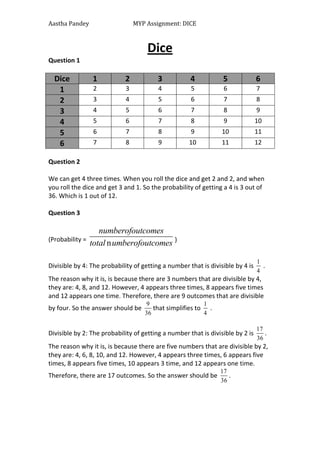
Dice myp assignment
- 1. Dice<br />Question 1<br />Dice123456123456723456783456789456789105678910116789101112<br />Question 2<br />We can get 4 three times. When you roll the dice and get 2 and 2, and when you roll the dice and get 3 and 1. So the probability of getting a 4 is 3 out of 36. Which is 1 out of 12. <br />Question 3<br />(Probability = ) <br />Divisible by 4: The probability of getting a number that is divisible by 4 is . The reason why it is, is because there are 3 numbers that are divisible by 4, they are: 4, 8, and 12. However, 4 appears three times, 8 appears five times and 12 appears one time. Therefore, there are 9 outcomes that are divisible by four. So the answer should be that simplifies to . <br />Divisible by 2: The probability of getting a number that is divisible by 2 is . The reason why it is, is because there are five numbers that are divisible by 2, they are: 4, 6, 8, 10, and 12. However, 4 appears three times, 6 appears five times, 8 appears five times, 10 appears 3 time, and 12 appears one time. Therefore, there are 17 outcomes. So the answer should be . <br />Divisible by 3: The probability of getting a number that is divisible by 3 is . The reason why it is, is because there are three numbers that are divisible by 3, they are: 6, 9 and 12. However, 6 appears 5 times, 9 appears 4 times and 12 appears one time. Therefore, there are 10 outcomes. So the answer should be that simplifies to . <br />Divisible by 6: The probability of getting a number that is divisible by 6 is. The reason why it is, is because there is only one number that is divisible by 6, it is: 12. Also, it appears only once on the table, therefore, there is only one outcome. So the answer is . <br />Explain: <br />For these questions the way I calculated it was very simple. If a number is “divisible by” then you can just think of their multiples. So I just counted how many whole numbers on the table can divide the number on the question and will get a 0. <br />Question 4: <br />Looking at the answers in question 3, a pattern could be found. First of all, to find the numbers all I had to check was that the outcomes can divide the numbers and get a result of 0 at the end. <br />To find the answers for 4, all that was needed to be done was multiplied by an outcome. If the answer is a whole number then it is divisible. This was the same for all three other numbers, with 2, 3, and 6. <br />So the final formula for this is . However, this formula doesn’t always apply to all the numbers, the final outcome has to be a factor of 36 to be used in this formula. Also, the range of the final outcome needs to 1 < n < 12 (greater than one and smaller than twelve). <br />Examples to prove this would be: <br />Example proving it False: <br />Finding the probability of a number that is divisible by 9: The probability is 0 because there are no multiples of 9 in the table. So this is proved False. <br />Finding the probability of a number that is divisible by 7: The probability is 0 because there are no multiples of 7 in the table. So this is proved False. <br />An example proving is True: <br />Finding the probability of a number that is divisible by 5: The probability is because the outcome that is divisible by 5 is 10, and there are three 10s in the table which is: , which simplifies to . <br />Question 5: <br />OutcomeNumber of outcomeProbability314356610715821925102711271225132114151510166173181SUM2161<br />My conjecture is valid for the three dice experiment as well, because as long as a number turns out to be a whole number after multiplied by and is 1 < n < 216 (greater than one and smaller than 216). <br />An example proving it True:<br />Finding the probability of a number that is divisible by 8: The probability of getting a number divisible by 8 is because there is one outcome overall that is divisible by 8, which is sixteen. Also, there are six sixteen’s so the probability is which then simplifies to . <br />This conjecture is valid, but at the same time may be invalid because some of the numbers don’t have other outcomes that can be divided with. <br />An example proving it False:<br />Finding the probability of a number that is divisible by 10: The probability is 0 because this number is too large for the chart, and there aren’t any other outcomes, in this table that is divisible by ten. <br />